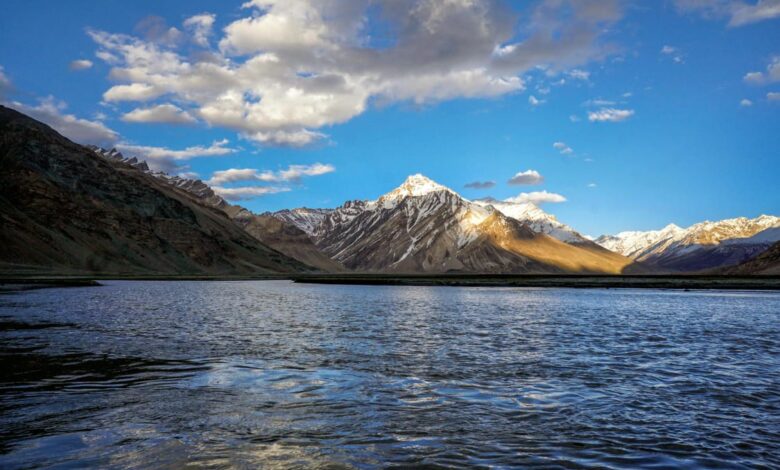The Enduring Spirit of Sherpas in the Everest Base Camp Trek

Spanning across Nepal, the Everest Base Camp Trek is one of the most popular and challenging trekking routes on our planet – bested only by those who long to step into the shadows of the tallest mountain in the world. But no trekker arrives at the base camp without the invisible backbone of the Sherpa nation, a race that refuses to break despite centuries of hardship. In the majestic Everest region, trekkers owe a great deal of gratitude to their Sherpas—who are as tough as the mountains and deeply bound to this region.
This commitment of the Sherpas with Himalayas is not only cultural but genetically inherited. Generations of them have lived in the Khumbu Valley, their strong familiarity with towering mountains and fickle weather patterns, not to mention thousands of trails carved by yaks, have made traditional guides and porters for teams of mountaineers or trekkers. Even the term “Sherpa,” referring to an ethnic group in Nepal, has become an umbrella term for mountain guide, thanks primarily to the accomplishments of these high-altitude pioneers. Their precision and power help them conquer the rough terrain, necessary to carry heavy objects and lead hikers over brutish weather and difficult circumstances.
Above all, however, the true distinction of Sherpas is their character and resilience forged from an inherent hospitality that is complemented by humility and generosity. Trekking towards Everest Base Camp, many are touched by the welcoming and help offered by so many Sherpas who aid in carrying goods up the mountain, break bread with trekkers or bring some humanity to an otherwise brutal landscape. They embody the local value of community and interconnection with nature well, creating a sense of fellowship between trekkers and other locals.
But this is not a job so much as a way of life: Sherpa are the unsung heroes of high-altitude mountaineering, performing logistical support and other menial labor for many professional climbers who simply do not have the time to acclimatize to their new elevation. The Sherpa scene below the Everest Summit was what enabled British expeditions robots at early peaks, so definitely their full time employment and expedition success follow. Over the years, a number of Sherpas have become iconic figures in their own right—Tenzing Norgay is only one among many famous for his bravery, determination and unflagging support to climbers. But the vast majority of Sherpas labour away in the background, making sure that trekkers and tourists alike are catered for and safe.
However, while their immense contribution to the trekking business cannot be overstated — Sherpas are still faced with many challenges. Climate change affects the region, and the Sherpas are at risk, too; they frequently take on the risks of leading trekkers through treacherous areas. However, at the heart of Everest Base Camp Trek is the Sherpas’ long-lasting spirit which is nourished by a profound culture and strong people called as high-mountain porters, without whom there would be no story about Everest. These are the men and women who get you safely to the foot of Everest, through blizzards and avalanches — their relentless dedication and resilience is what keeps the Everest Base Camp Trek open to anyone with a will to travel.
Spanning across Nepal, the Everest Base Camp Trek is one of the most popular and challenging trekking routes on our planet – bested only by those who long to step into the shadows of the tallest mountain in the world. But no trekker arrives at the base camp without the invisible backbone of the Sherpa nation, a race that refuses to break despite centuries of hardship. In the majestic Everest region, trekkers owe a great deal of gratitude to their Sherpas—who are as tough as the mountains and deeply bound to this region.
This commitment of the Sherpas with Himalayas is not only cultural but genetically inherited. Generations of them have lived in the Khumbu Valley, their strong familiarity with towering mountains and fickle weather patterns, not to mention thousands of trails carved by yaks, have made traditional guides and porters for teams of mountaineers or trekkers. Even the term “Sherpa,” referring to an ethnic group in Nepal, has become an umbrella term for mountain guide, thanks primarily to the accomplishments of these high-altitude pioneers. Their precision and power help them conquer the rough terrain, necessary to carry heavy objects and lead hikers over brutish weather and difficult circumstances.
Above all, however, the true distinction of Sherpas is their character and resilience forged from an inherent hospitality that is complemented by humility and generosity. Trekking towards Everest Base Camp, many are touched by the welcoming and help offered by so many Sherpas who aid in carrying goods up the mountain, break bread with trekkers or bring some humanity to an otherwise brutal landscape. They embody the local value of community and interconnection with nature well, creating a sense of fellowship between trekkers and other locals.
But this is not a job so much as a way of life: Sherpa are the unsung heroes of high-altitude mountaineering, performing logistical support and other menial labor for many professional climbers who simply do not have the time to acclimatize to their new elevation. The Sherpa scene below the Everest Summit was what enabled British expeditions robots at early peaks, so definitely their full time employment and expedition success follow. Over the years, a number of Sherpas have become iconic figures in their own right—Tenzing Norgay is only one among many famous for his bravery, determination and unflagging support to climbers. But the vast majority of Sherpas labour away in the background, making sure that trekkers and tourists alike are catered for and safe.
However, while their immense contribution to the trekking business cannot be overstated — Sherpas are still faced with many challenges. Climate change affects the region, and the Sherpas are at risk, too; they frequently take on the risks of leading trekkers through treacherous areas. However, at the heart of Everest Base Camp Trek is the Sherpas’ long-lasting spirit which is nourished by a profound culture and strong people called as high-mountain porters, without whom there would be no story about Everest. These are the men and women who get you safely to the foot of Everest, through blizzards and avalanches — their relentless dedication and resilience is what keeps the Everest Base Camp Trek open to anyone with a will to travel.
The Role of the Sherpa in Mountaineering
The role of the Sherpas in mountaineering, especially on Everest expeditions, cannot be stressed enough. Since British climbers first attempted to climb Everest, Sherpas have supported almost every expedition — and their contributions are vital to the success of most climbers. But they are more than simple porters; the Sherpas are highly trained mountain guides with a knowledge of their region, its weather and its dangers unequal anywhere else on earth. Without the Sherpas who set up camps, carried equipment and guided their clients through deadly conditions, many of the world’s most iconic climbs rain honey bitter never would have been achieved. It is not the first time, however, that Sherpas have been key to climbing success — they most famously enabled Sir Edmund Hillary and Tenzing Norgay reach the top of Mount Everest in 1953, but relevant skills have remained central to many successful climbs ever since. But even today, Sherpas are an essential part of any Everest expedition; they often become the de facto first ascenders of a route and are typically embedded in the climbing teams themselves. Not only do they provide physical support for climbers, but their knowledge of the mountains and level of environmental reading that many climbers are simply not at make them invaluable in high-altitude mountaineering.
Sherpa Knowledge and Experience on Tours at Altitude
Sherpas are not a hiking or trekking people, sherpas have a unique skill passed down for generations making them the most proficient of all with high-altitude trekking. Their endurance and mental strength are astonishing, carrying great weights considerably more than their body weight while traversing perilous thin air. To some extent Sherpas are adapted to cope with high-altitude environment which climbers often cannot, because their body is accustomed to the lower oxygen at extreme high latitude. They have learnt to read altitude sickness, the behaviour of the weather and the character of the different routes throughout Everest land. Such skills are essential on treks such as the Everest Base Camp trail, which can be rugged, constantly changing underfoot and is vulnerable to sudden changes in the weather. In addition, Sherpas are also our cultural guides, they tell you all about the history of Khumbu Valley, its traditions and sacred sites. Their skills are not restricted to the physical; they also provide emotional and psychological support for trekkers struggling with the rigors of the trek. That mix of physical, mental and cultural strength is what makes Sherpas an irreplaceable part of the Everest trekking and climbing experience.
Sherpas on Everest: the Problems They Face
Even though these challenges are essential to the work involved in expeditions on Everest, Sherpas tackle many problems throughout their tours. The pollutant type at the high-altitude environment is one of the most serious barriers. At heights above 5,000 meters the air grows thin — and even the most experienced climbers would suffer extreme fatigue, headaches and nausea within hours of struggling to breathe alongside the need to carry heavy equipment. The Sherpas, on the other hand, are adapted to such extreme conditions but have paid a lot of loyalty over the years in terms of wear and tear. One factor is the always unpredictable weather on the mountain. Cramped with deadly avalanches, rockfalls and snowstorm, expeditions can rapidly become matter of life or death. Sherpa have a deep experience in these risks, yet the dangers are not absent. One of the big problems they face is a rise in recent years of trekkers and climbers on Everest, resulting in queues on popular routes point, especially in peak seasons. This not only made logistics a challenge but also increased the chances of an accident or emergency. Sherpas receive a small fraction of the amounts paid by climbers to get themselves on top—which is another sticking point in the mountaineering business. However, the desperation which comes from these issues doesn’t seem to diminish Sherpas’ sense of obligation and bravery — their work on Everest cannot be replaced.
Working in Extreme Conditions: Risky Business
To start, working on Everest is risky work and Sherpas are well aware of the risks that come with high-altitude labor. One example is exposure to extreme weather, which can happen via avalanches, blizzards and rockfalls. Sherpas also have a job to pitch camps and haul stuff at elevation where the air is thin meaning oxygen is sparse, making it harder for even routine efforts. It seems that this physical work affects their health since they are exposed to low oxygen levels for long periods, and altitude sickness can develop as a result if not treated well and it can become deadly. Sherpas are also more likely to be injured, often as they will be the first people on route or taking supplies through dangerous or unstable areas. There has been more scrutiny over the dangers of Sherpas work in recent years, as many have died when things go wrong on Everest. Still, it is the strength and bravery of Sherpas that forms the spine of Everest expeditions even with all those threats. Nonetheless, people are starting to realize that Sherpa Lounges, who have a job that is fraught with risk and expense, should be compensated rightfully along with their working conditions becoming somewhat better.
SHERPA – Traditions and spirituality
The Sherpa people have a profound spiritual bond with their home in the mountains that extends beyond just their geographic location. The Sherpas practice Tibetan Buddhism, and their beliefs are inextricably connected to the natural world around them; specifically, the mountains. Also, Mount Everest is considered sacred by the Sherpas because they consider the mountain as home to gods & spirits who are watchfully watching over them. Rituals are often performed by Sherpas for the blessings of these deities before embarking on treks or climbing expeditions, promising them a safe journey. These can be at holy places like monasteries, stupas or chortens, and prayer for protection or success. You can see the Sherpas’ spirituality in their daily lives, prayer flags fluttering with seasonal winds, mantras carved into rocks dotting the land. This encompasses everything from festivals to communal feasts and ceremonies that honor the interconnection between people, nature and spirit. These are vital not just to Sherpa identity, but also show their awe for the natural environment around them. Familiar with Sherpa traditions, many climbers have come to appreciate and respect the Sherpas’ spiritual reverence for Everest — recognizing that their role on the mountain is about more than just muscle.
The Role of Sherpas in Mountaineering Trips
When it comes to high-profile expeditions such as those to the top of Mount Everest, Sherpas have given so much. Since the earliest attempts to climb Everest by British explorers, Sherpas have been undoubtedly key in almost every expedition that has sought conquest of the mountain. Sherpas do much more than carry heavy loads, though; they are skilled guides who understand the geography, climate, and hazards of the Everest region better than anyone else. Acheiveing many of the world top climbs simply would not have been possible without help from sherpards setting camps, wearing packs and leading through perilous enviroments. While the contributions of Sherpas played a role in Sir Edmund Hillary and Tenzing Norgay reaching Mount Everest summit in 1953, their efforts have been vital to many successful summits since. Sherpas still perform some of the most important duties on Everest today, even being among the top high altitude guides and climbing team members. What set them apart is not just the direct physical support they provide climbers; their intimate knowledge of the mountains and ability to read the environment in ways few climbers can make them essential to high-altitude mountaineering.
Sherpa characteristics: Expert climbers in high altitude hiking
Over the centuries, Sherpas have developed rare capabilities that make them ideal candidates for high-elevation trekking. Their physical stamina and mental toughness are incredible, allowing them to carry heavy loads, frequently more than their own weight in harsh and very thin airstreams. Unlike many climbers, the bodies of Sherpas are accustomed to the low oxygen levels found at extreme elevations, adapting over generations to this high-altitude environment. With the years and experience they have gained a sense on altitude sickness, how the weather acts and interaction very closely with the different routes of Everest region. These skills are especially important on treks like the trail, where the terrain can be rocky, unpredictable, and climb in a moment of time. Sherpas are also cultural guides, providing rich context of the history and traditions of the Khumbu Valley, its sacred sites. It’s not only physical, but mental also, they offer support to trekkers who may find the trekking conditions too much. Such fitness, mental strength, and cultural wisdom make Sherpas an inseparable part of the Everest trekking/ climbing culture.
Sherpas Have to Face These Problems on Everest
However, while important, Sherpas have a number of problems when working on Everest Expeditions. Almost all of the greatest challenges will come down to the environment, and that includes its altitude. Above about 5,000 meters — 16,400 feet — the air becomes so thin that it can induce crippling fatigue and headaches associated with nausea, and makes using supplemental oxygen to breathe heavy loads challenging. But sherpas, whose bodies are made to run this gauntlet, pay for it in the long term with extreme strains. Mountain weather can also be unpredictable, another factor reason for one of the Olympic Games in China. The risk of landslides, rock falls, and snow storms are high and can transform an expedition into a matter of life or death in no time. While approaches to these risks are well known by Sherpas, the dangers never dissipate. A developing predicament they are confronted with is the increasing volume of trekkers and climbers on Everest, which has resulted to significant blockage along popular courses especially in top seasons. This has resulted not just in logistical challenges, but also heightened the potential for accidents and emergencies. Moreover, Sherpas are frequently compensated less than the climbers they help climb and this has been a sore issue in climbing business. Yet this sense of duty, courage, and dedication to their profession — which remains vital during Everest expeditions — is evident among the Sherpas despite these challenges.
The Pitfalls of Operating in Extreme Environments
There is danger in working on Everest, and Sherpas are all too familiar with the hazards high-altitude work involves. Among the many risks are that of extreme weather, such as avalanches, blizzards and rockfalls that often strike up on you rather quickly. Furthermore, Sherpas do establish camps and haul immense weights at elevations where the air is empty and oxygen is rare that can make simple actions seem more difficult in nature. The health cost of this physical wear and tear is steep, because chronic low levels of oxygen can produce altitude sickness — a life-threatening condition without proper management. The guides, known as Sherpas take on an added degree of danger due to the fact that they are often the first in line when trudging through treacherous or unstable terrain. Several Sherpas have died in recent years while working on Everest, highlighting the perilous work they do. Even with these dangers, Sherpas remain the backbone of Everest expeditions and show immense bravery and endurance throughout. Increasingly, however, people recognize that Sherpas need better safety standards and higher pay for an inherently risky profession.
Sherpa Religious Beliefs and Customs
However, the bond that the Sherpa people have to their mountainous homeland is not just a physical connection but spiritual, too. The Sherpa have practiced Tibetan Buddhism for centuries, and their spirituality is tightly bound to the natural world — especially the towering mountains that surround them. For Sherpas, Mount Everest (or Sagarmatha in Nepali or Chomolungma in Tibetan) is sacred and believed to be home to gods and spirits. Traditionally before treks or climbing missions, Sherpas conduct offerings to the god [to] ensure a safe passage. These could be the offerings made at holy places such as monasteries, stupas or chortens or prayers for protection and accomplishment. Prayer flags flutter in the wind above home after home while stones scattered across the landscape are inscribed with sacred mantras conveying an unmistakable sense of daily spirituality unique to the Sherpas. Festivals, collective feasts and rituals which honor the relationship between people, nature and God are also part of their traditions. Such practices are central to Sherpa identity and deep respect for the natural world. With the Sherpa culture being interdependent with Everest climbing, many climbers pay respect to this spiritual connection between the Sherpas and mountains by understanding that their helper’s job on the mountain is not only a physical service but also a cultural and personal responsibility.
Sherpas and the Economic Significance of Everest Trek
The has evolved into an integral means of sustenance for the Sherpa community and provides huge business influx to people residing in Khumbu zone of Nepal. Sherpas have made a living for generations as porters, guides and support to mountaineers and trekkers who pay them wages that provide livelihoods to their families and communities. With the increase of tourism to Everest over the last couple decades has come a more prosperous windfall for Sherpas. In particular, the Everest Base Camp trek has become a mecca for trekkers around the world and Sheraps are an integral part of making these treks profitable. Many Sherpas are guides who take groups up the strenuous path to Base Camp, and others work as porters carrying heavy loads of equipment, food, and supplies. These profitable ventures in turn help not only the families but also support local accommodations like lodges, teahouses, and restaurants. But the same swarm of trekkers that picked its rosebud has been poking at economic inequalities. While climbing is a dangerous and complicated business, the men (and women) who work as Sherpas carrying loads for trekking companies or some of the biggest mountaineering expeditions only earn relatively small wages. Such increasing dependence upon tourism has in turn raised the issue of sustainable salary as well as safety and working conditions for Sherpas. The Everest trek has been an economic godsend for the Sherpa community but their climb towards fairer pay and secure working conditions continues.
Sherpa in 21st century: The changing life
Sherpa life is changing much in the 21st century, primarily because of a massive influx of tourism and the worldwide prominence of Mount Everest. Sherpas once lived in small villages, eking out a living from farming, herding and traditional crafts. But the financial boom of trekking in the Everest region saw Sherpas more incorporated into the world economy and many now depend on wages from guiding and portering. Sherpas have greatly benefited from the expanding opportunity in tourism, but it has brought challenges to traditional ways of life and practices. Sherpas in the last few decades have started to become more engaged with trekkers and climbers from around the globe which has been great for exposure, yet has also led to an increasing number of young Sherpas receiving a better education than their ancestors through local schools or even universities in larger cities, returning home wanting nothing to do with the trekking life. Despite all of this change, Sherpas remain culturally tied to their heritage through Tibetan Buddhism, though many Sherpas have also adopted what is known as the Newars Buddhist tradition, in addition to their base practices and way of life. The rise of social media and new tech also led them to tell their stories in a way that has fundamentally changed our perception of the Sherpa, especially as it relates to the mountains. Still, this fast pace of change causes environmental impacts and challenges the sustenance of Sherpa traditions.
Sherpa Environmental Stewardship and Conservation
The sustainability of the natural environment surrounding Everest has been managed by Sherpas for generations, but their contributions to environmental preservation are becoming more and more crucial. Alongside the increasing number of trekkers and climbers to Everest, there has been a growing environmental cost of tourism in this part of the world. Sherpas are mountain folk, they live in harmony with the land near Everest and care for preservation of their lands for generations to come. And many Sherpas are now outspoken activists for being good stewards of the environment. The problems that litter, rubbish and illegal lumberjacks create is spiralling out of control in the region. The buildup of waste left behind by trekkers and climbers has been perhaps the largest concern, notably near Everest Base Camp or other common trekking paths. In recent years, Sherpas have spearheaded efforts to clean the mountain by organizing trash collection campaigns and promoting responsible trekking among tourists. In addition, Sherpas have contributed to promoting responsible tourism practices that safeguard the environment and maintain the natural splendor of the Himalayas. The government of Nepal, along with small groups of Sherpas and conservation organizations, have implemented regulations on waste disposal, green trekking permits, and trekker guidelines to reduce the impact on the environment. The Sherpas have a spiritual connection that will keep them grounded over the centuries to mount Everest and its territory, when their immense knowledge of nature fully conjoins with modern practices healthily skewering the pests of mass tourism.
From Tenzing Norgay to Others: The Legacy of the Famous Sherpas
Maybe the best representation of Sherpas in mountaineering legacy is Tenzing Norgay who was, with Sir Edmund Hillary, one of the first two men to — doing so in 1953. Tenzing after winning Escape into Light, Solenopsis, through the field. Tenzing’s achievements broke down the stereotype of Sherpas as simple porters and helped to promote them to team equals that needed recognition for their skill. Many more Sherpas gained worldwide fame for climbing in the post-Tenzing years. The Sherpa have made a name for themselves in the world of high-altitude climbing with figures such as Ang Rita, who is famous for making it to the summit of Everest without supplemental oxygen, and Apa Sherpa, who holds the record of all time summits on Everest. The climbers and the guides have collectively contributed to changing the perception of Sherpas around the globe, realizing that these people are not merely service provider, but world class sports men and women in their own right. In addition, the Sherpas continue to inspire generations of climbers — they work as guides on Everest today, often leading commercial expeditions and still within their own rights pushing up against the limits of human capability. Famed Sherpas such as Tenzing Norgay forged a new legacy with their lives that speaks to the strength, skill and unyielding connection of this community with the mountains they have inhabited for centuries.
Conclusion: Everlasting Spirit and Endurance of people behind the Everest hike
The Sherpas are the lifeline of Everest and yoke a spirit that endures for centuries. Trained for decades in some of the most dangerous terrain on Earth, carrying enormous packs through extreme conditions, they have served as true mountain guides and custodians of the Everest region. The role of the Sherpas The Sherpas are vital to successful Everest expeditions, their expertise and knowledge of the land is invaluable, and due to their cultural and spiritual connection with these mountains they provide a depth and meaning that really resonates throughout your time on . The legacy of Sherpas, represented by heroes like Tenzing Norgay, lives on and defines the future of both climbing and trekking. Though their work is fraught with danger, from the high-altitude perils to changing dynamics within their communities, the Sherpa’s determination holds strong. The Sherpa community responds to the modern challenges facing their way of life whilst remaining well connected with their traditions and values when it comes to mountaineering which continues its evolution in many different ways. Sherpas have a role on Everest that goes beyond carrying gear ~ it speaks of the strength ever-present in their culture, the long-standing history they possess as protectors of the mountain but also the spirit they help those seeking glory climb with.




